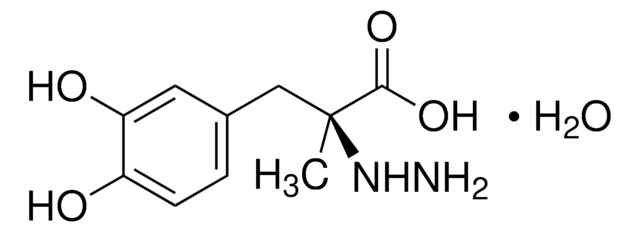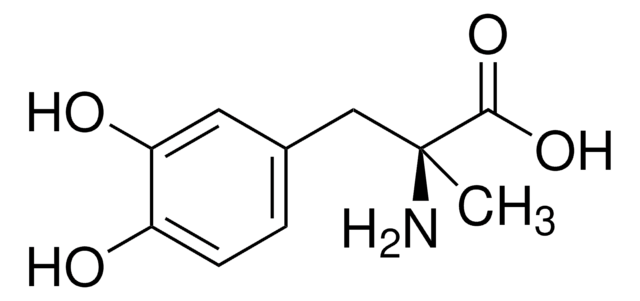推薦產品
等級
pharmaceutical primary standard
API 家族
levodopa
製造商/商標名
USP
mp
276-278 °C (lit.)
應用
pharmaceutical (small molecule)
形式
neat
儲存溫度
2-8°C
SMILES 字串
N[C@@H](Cc1ccc(O)c(O)c1)C(O)=O
InChI
1S/C9H11NO4/c10-6(9(13)14)3-5-1-2-7(11)8(12)4-5/h1-2,4,6,11-12H,3,10H2,(H,13,14)/t6-/m0/s1
InChI 密鑰
WTDRDQBEARUVNC-LURJTMIESA-N
基因資訊
human ... DRD3(1814)
尋找類似的產品? 前往 產品比較指南
一般說明
This product is provided as delivered and specified by the issuing Pharmacopoeia. All information provided in support of this product, including SDS and any product information leaflets have been developed and issued under the Authority of the issuing Pharmacopoeia.For further information and support please go to the website of the issuing Pharmacopoeia.
應用
Levodopa USP reference standard, intended for use in specified quality tests and assays as specified in the USP compendia. Also, for use with USP monographs such as:
- Carbidopa and Levodopa Tablets
- Carbidopa and Levodopa Orally Disintegrating Tablets
- Carbidopa and Levodopa Extended-Release Tablets
分析報告
These products are for test and assay use only. They are not meant for administration to humans or animals and cannot be used to diagnose, treat, or cure diseases of any kind.
其他說明
Sales restrictions may apply.
相關產品
產品號碼
描述
訂價
訊號詞
Warning
危險分類
Acute Tox. 4 Oral - Eye Irrit. 2 - Skin Irrit. 2 - STOT SE 3
標靶器官
Respiratory system
儲存類別代碼
11 - Combustible Solids
水污染物質分類(WGK)
WGK 3
閃點(°F)
Not applicable
閃點(°C)
Not applicable
客戶也查看了
Damian M Herz et al.
Annals of neurology, 75(6), 829-836 (2014-06-04)
In Parkinson disease (PD), long-term treatment with the dopamine precursor levodopa gradually induces involuntary "dyskinesia" movements. The neural mechanisms underlying the emergence of levodopa-induced dyskinesias in vivo are still poorly understood. Here, we applied functional magnetic resonance imaging (fMRI) to
PvdP is a tyrosinase that drives maturation of the pyoverdine chromophore in Pseudomonas aeruginosa.
Pol Nadal-Jimenez et al.
Journal of bacteriology, 196(14), 2681-2690 (2014-05-13)
The iron binding siderophore pyoverdine constitutes a major adaptive factor contributing to both virulence and survival in fluorescent pseudomonads. For decades, pyoverdine production has allowed the identification and classification of fluorescent and nonfluorescent pseudomonads. Here, we demonstrate that PvdP, a
Nicolas Morin et al.
Experimental neurology, 256, 105-116 (2013-01-31)
The treatment of motor symptoms of Parkinson disease (PD) with the dopamine (DA) precursor, l-3,4-dihydroxyphenylalanine (l-DOPA) introduced 50years ago still remains a very effective medication. However, involuntary movements termed l-DOPA-induced dyskinesias (LID) appear in the vast majority of PD patients
Lukas L Imbach et al.
Parkinsonism & related disorders, 20(11), 1283-1286 (2014-09-28)
Diagnosis and treatment of tremor are largely based on clinical assessment. Whereas in some patients tremor may respond to dopaminergic treatment, in general l-Dopa response to tremor varies considerably. The aim of this study was to predict l-Dopa response by
Vincent J J Odekerken et al.
Neurology, 84(13), 1355-1361 (2015-03-01)
To assess the neuropsychological outcome 12 months after bilateral deep brain stimulation (DBS) of the globus pallidus pars interna (GPi) or subthalamic nucleus (STN) for advanced Parkinson disease. We randomly assigned patients to receive either GPi DBS or STN DBS.
我們的科學家團隊在所有研究領域都有豐富的經驗,包括生命科學、材料科學、化學合成、色譜、分析等.
聯絡技術服務







